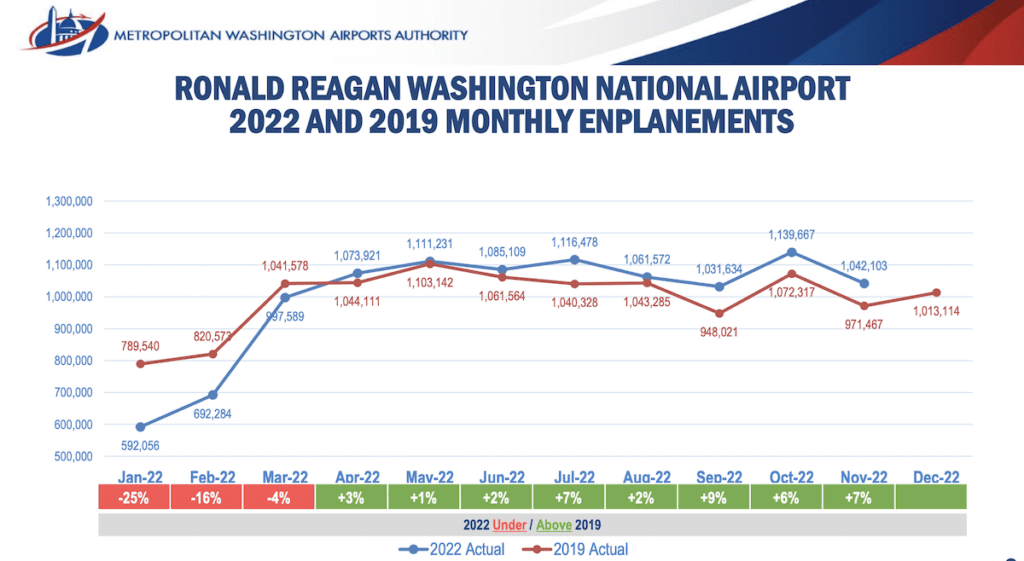Washington Reagan's Traffic Exceeds 2019, That's Not Necessarily Good for American Airlines

Photo Credit: American will begin flying out of a new concourse at Washington National airport next Tuesday, but the opening is the exception during the crisis. Airline Weekly / Edward Russell
Travelers enjoying a pie from Washington, D.C.'s local favorite, Timber Pizza, while waiting for a flight to, say, Syracuse at Washington Reagan National Airport will enjoy one of America's newest airport facilities. Opened in 2021, the new E Gates sport floor-to-ceiling windows with comfortable wingback chairs where flyers can take in the view of the Capitol city's monuments across the Potomac River.
What they won't see are unpopular and inefficient 50-seat regional jets waiting to fly them to their destinations. American Airlines, which uses the E Gates and maintains a hub at Washington National, replaced all of their flights on the small jets with larger models, like the Embraer E175, that sport multiple classes and are more popular with both passengers and airlines. That has meant more seats overall at the D.C.-area airport even as National's bread-and-butter local business traffic has yet to return.
“American [is] now able to better utilize a strategically located airport as a north-south hub for passenger flow," said Paul Bobson, vice president of airline business development at operator Metropolitan Washington Airports Authority (MWAA), during a recent board meeting. He added that the traffic increase was one of the “long-term benefits of Project Journey."

Project Journey is the $1 billion expansion of Washington National that included the new concourse and security checkpoints in Terminal 2. Most of the work was completed in 2021, though some last pieces are still underway. The E Gates, specifically, were built to improve the customer experience and increase capacity by replacing the widely derided Gate 35X, which was compared by some to a bus station. The ground-level gate served as the gateway to 14 remote aircraft parking positions used by American for regional jet flights.
But the opening of Project Journey in 2021 came as air travel was still recovering from the pandemic. Leisure travelers were back in force but the return of corporate flyers lagged well behind those on holiday trips. Add to that, the Federal Aviation Administration ended pandemic-era slot usage waivers for domestic flights at U.S. airports in late 2021, which forced American and other airlines to operate nearly their full schedules at National even where demand remained weak.
American, flying larger planes and its full schedule despite lower demand, had to fill its planes at Washington National somehow. Enter connecting traffic.
In the third quarter, American carried 108 percent more transfer passengers at National than it did in 2019, Bobson said. That represented a far greater increase than the number of additional seats that the airline was flying, which were up on average 11 seats per departure.
Connecting passengers typically, though not always, pay lower fares than local ones. This makes the shift for American not necessarily a good one financially. However, as the carrier does not break out profitability or yields by hub or airport, it is difficult to determine the financial impact of the shift to more connecting passengers at National as its overall domestic profitability has improved.
An American spokesperson declined to comment, citing the airline's scheduled fourth-quarter earnings call on Thursday.
Domestic passenger revenue per available seat mile, or PRASM, at American was up 20 percent year-over-three-years in the third quarter, the airline's latest financial results show. Overall corporate revenues exceeded 2019 levels driven largely by more travel from small- and medium-sized businesses, while revenues from so-called managed business accounts — in other words, large corporations — were still down roughly 20 percent.
Data from trade group Airlines for America (A4A) show that the volume of corporate tickets sold in the U.S. was down roughly 24 percent from 2019 levels during the week ending January 15.
Higher passenger numbers at Washington National do benefit MWAA. The increase directly correlates to higher airport revenues, both in terms of fees and concessions. MWAA's airline revenues at its two airports — Dulles and National — exceeded its budget forecast by 5 percent during the first 11 months of 2022, its latest financial report shows. This occurred even as passenger numbers at Dulles — the D.C. region's main international gateway and a hub for United Airlines — still lagged 2019 levels by a good margin.
MWAA can also claim a larger share of FAA funding to airports that is allocated based on passenger numbers. The busiest airports receive the largest amounts. The FAA's competitive grant programs, including the $5 billion included in the Bipartisan Infrastructure Law, are separate from this.
Travel patterns at Washington National, and American's hub there, are likely in a transition moment. Travel patterns shifted during the pandemic with people traveling in new ways, for example the surge in blended travel that include aspects of both leisure and business trips. However, given National's unique role as the main domestic gateway to the U.S. capital and slot limits that bar any growth in flight numbers, it is likely that business travelers will regain some of their historic share on flights to and from the airport. The question is really what transfer volumes look like once the recovery dust settles.
